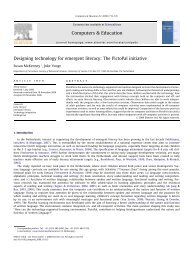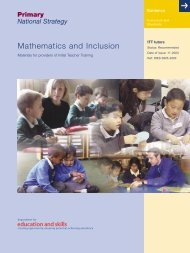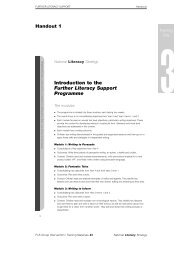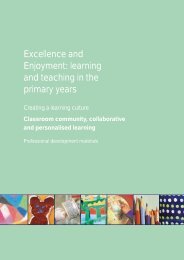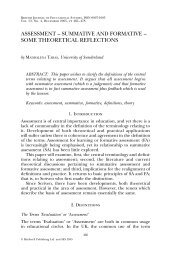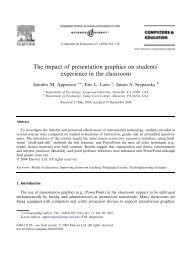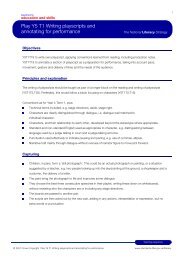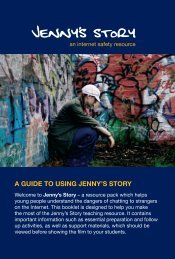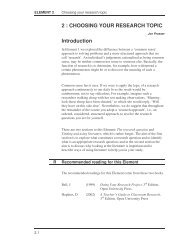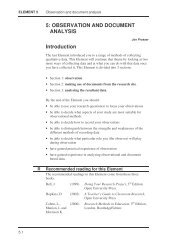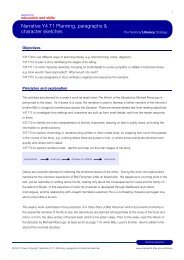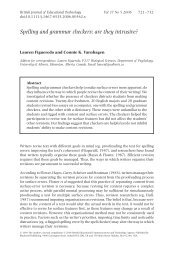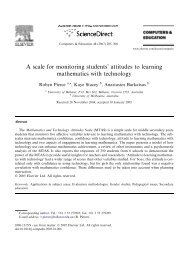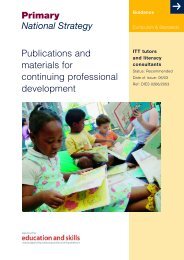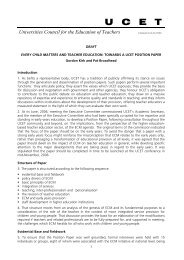Module 2: Written feedback - PGCE
Module 2: Written feedback - PGCE
Module 2: Written feedback - PGCE
You also want an ePaper? Increase the reach of your titles
YUMPU automatically turns print PDFs into web optimized ePapers that Google loves.
4.2 Developing written <strong>feedback</strong> 35 minutes<br />
Introduce this section by displaying slide 4.2.4 to show some research findings<br />
into <strong>feedback</strong> and pupils’ response to it.<br />
Slide 4.2.4<br />
Explain the following.<br />
• Changing the way teachers provide written <strong>feedback</strong> to pupils, including<br />
the marking of their work, to make <strong>feedback</strong> more focused and selective<br />
requires teachers, pupils and parents to understand the rationale and<br />
the process.<br />
• Clear guidance needs to be agreed as to the regularity of detailed<br />
written <strong>feedback</strong> and departments need to identify the key pieces of work<br />
to focus upon.<br />
• The use of marks, grades and levels and how these are recorded and<br />
shared with parents need to be agreed at whole-school level.<br />
Task A (20 minutes)<br />
Tell participants the following.<br />
• The task involves looking at a range of teacher comments and suggesting<br />
whether they consider the <strong>feedback</strong> to the pupils to be helpful.<br />
• The participants are provided with handout 4.2.1 which gives:<br />
– a number of teacher comments;<br />
– some criteria to help participants judge the helpfulness of the comments<br />
to the pupils.<br />
Handout 4.2.1<br />
Handout 4.2.1<br />
Handout 4.2.1 cont.<br />
Teacher comment Does the <strong>feedback</strong> provide information to the pupil about:<br />
whether they are their limitations and a way to improve a way to think through<br />
on the right track? encourage them to their learning? the answer for<br />
correct work? themselves?<br />
You started off well. Unfortunately you have made the<br />
same error in the last three questions. Can you see<br />
what this is? You may find it helpful to go back to the<br />
grid method.<br />
Your poem about copper sulphate was interesting. We<br />
need to discuss how you think copper crystals are<br />
made.<br />
Attainment 3 Effort 2<br />
You have made good progress in your handwriting.<br />
Your spelling still needs work.<br />
I think we need to talk about this work in more detail.<br />
Yet again you have not completed the work.<br />
Well done Simon. This is a very impressive article<br />
about the pros and cons of nuclear power. It was well<br />
presented as a newspaper article and I liked your<br />
quotes from different members of the public.<br />
The concerns you started to raise about nuclear waste<br />
perhaps need some further discussion. We can talk<br />
about this next lesson.<br />
Teacher comment Does the <strong>feedback</strong> provide information to the pupil about:<br />
whether they are their limitations and a way to improve a way to think through<br />
on the right track? encourage them to their learning? the answer for<br />
correct work? themselves?<br />
Well done – 1 merit<br />
A good ‘best fit graph’. The conclusion clearly explains<br />
the relationship between the force and the extension<br />
of the spring.<br />
There are a lot of inaccuracies in this work. Please<br />
check it through again.<br />
This work shows you have clear understanding of<br />
finding the areas and perimeters. What strategies did<br />
you use to calculate the answers? What were<br />
the important steps for you?<br />
You’ve plotted some interesting shapes. Well done!<br />
You have included more adjectives, which help bring<br />
the character alive on the page, but your sentence<br />
structure is not as varied as John’s. Experiment more<br />
by using complex sentences.<br />
Cracking piece of work. I like the diagrams and the<br />
interesting way you presented the impact of man on<br />
the environment. Keep it up!<br />
• The criteria have been adapted for the task from the research findings<br />
highlighted at the start of the module.<br />
4 Whole-school development in assessment for learning | Presenter’s Notes © Crown copyright 2004



